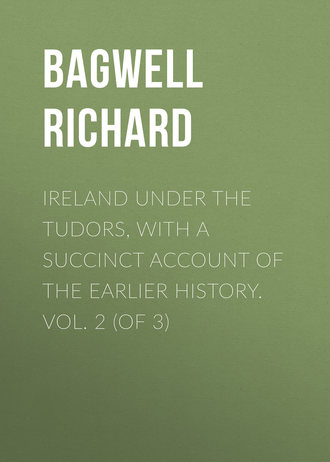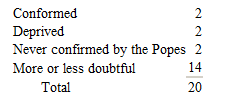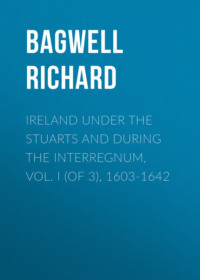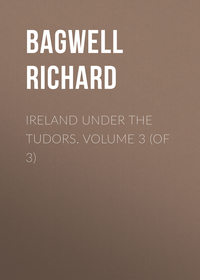 полная версия
полная версияIreland under the Tudors, with a Succinct Account of the Earlier History. Vol. 2 (of 3)
357
Lord Deputy and Council to the Privy Council, Aug. 1; Waterhouse to Sidney, July 4, in the Sidney Papers, where also are the Instructions for Snagg and Briskett; Sidney’s Summary Relation, 1583.
358
Letter of advice to Lord Grey, Sept. 17, 1580, in the Sidney Papers. Sidney to the Queen, Sept. 15, 1577, in same; to the Queen (after reaching England), Sept. 18, 1578.
359
Lady Mary Sidney to Edward Molineux, Oct. 11, 1578, and a second letter (undated) soon after, in the Sidney Papers. It is the Book of Howth which accuses Sidney of being a ‘lusty feeder and surfeiter.’ The Irish nickname might very well come from some dispute with a contractor, and not from Sidney’s fondness for malt liquor. Sidney died in 1586, prematurely old, at fifty-seven years of age. In the British Museum a black letter pamphlet contains a funeral sermon by Thomas White, D.D., the founder of Sion College. The whole is interesting, more especially the following passage: ‘He consumed himself in yielding light to other men; besides his special gift of affability to poor and simple men, the very grace of all his greatness. It is no hard matter for a man to be humble in low estate, but to be lowly in greatness is not a common gift; and if pride herself be often forced to dissemble humility, because lowliness maketh a simple man to be highly commended, how much more doth it excel, when it shall indeed appear in persons of value and renown! Wherefore if any man will build his house high, let him lay his foundations very low, for envy shoots at high marks, and pride goes before a fall.’ Herein lay the secret of Sidney’s immense popularity. His haughtiness was reserved for the great and powerful.
360
The story of the bleeding Christ is in Strype’s Life of Parker. The item about the Bibles is given by Mant on the authority of the Loftus MS.
361
Sussex to Cecil, Dec. 25, 1561; Lord Deputy and Council to the Queen, Sept. 2, 1562; Loftus to Cecil, Nov. 3, 1566, and March 21, 1567; Richard Creagh to Sidney, Dec. 25, 1566.
362
The Queen to Lord Deputy Sidney, July 6, 1567, authorising him to make Terence Daniel Primate; Terence to Cecil, Oct. 5, accepting the charge. In a letter to Lord R. Dudley, July 23, 1564, Sir T. Wrothe says Daniel ‘would promise to do much with Shane O’Neill, and some think he could perform it.’
363
Brady’s Episcopal Succession. Lord-Lieutenant and Council to the Queen, July 16, 1561.
364
Brady’s Episcopal Succession. Creagh’s own statement in Spicilegium Ossoriense, i. 41, from the Vatican archives; his examinations, in the Irish State Papers, Feb. 22, March 17 and 23, 1565.
365
Most of the documents relating to Creagh are collected in Spicilegium Ossoriense, vol. i. pp. 38-58. Holing’s account is at p. 84. The Jesuit makes Creagh’s escapes miraculous, but admits that he was on parole not to leave the Tower. This may account in some degree for the severity with which he was afterwards treated. See also a story, which may be apocryphal, in O’Sullivan Beare, tom. ii. lib. iv. cap. 10.
366
Brady; Loftus to Cecil. July 16, 1565; Holing in Spicilegium Ossoriense.
367
Brady; Cotton’s Fasti.
368
Brady; Cotton.
369
Brady; Cotton; Holing in Spicilegium Ossoriense.
370
Brady; Cotton; Ware; Alexander Craik to Lord R. Dudley, April 30, 1561; to Cecil, Jan. 2 and 10, Feb. 10 and 18, April 23, 1562, and Aug. 5, 1563; Robert Daly to Cecil, July 2, 1565.
371
Brady; Cotton; Instructions to Sir H. Sidney, July 4, 1565; Shirley’s Original Letters, p. 101; Graves’s History of St. Canice’s Cathedral, p. 295.
372
Brady; Cotton; Memoranda of private suits, July 16, 1559.
373
Brady collects most that is known about this curious rivalry; see also Spicilegium Ossoriense, i. p. 83, and Hooker under the year 1567. For MacCaghwell, see Loftus to Cecil, July 3 and Nov. 7, 1566, and Shirley’s Original Letters, p. 132.
374
Brady; Cotton; Captain Gilbert Yorke to Walsingham, Dec. 5, 1579; and several letters of Bishop Middleton, with recriminating answers on the part of the townsmen.
375
Brady and Cotton.
376
Brady and Cotton.
377
Brady; Cotton. Ware mentions a Bishop-elect of Kilfenora in 1585, but the appointment seems to have come to nothing. No doubt the see was extremely poor.
378
Brady and Cotton.
379
The above is from a close comparison of the data in Cotton and Brady, and in the Parliamentary Lists in Tracts Relating to Ireland, vol. ii. The twenty prelates mentioned in the list of 1560 are thus disposed of: —

380
Lord Deputy Sidney and Council to the Privy Council, April 15, 1566.
381
Hogan’s Hibernia Ignatiana, pp. 15 to 20. Wolfe’s commission to Thady Newman is in the R.O., Dec. 7, 1563; Interrogatories for Kian O’Gara and others, May 1572; Matthew Seaine, Bishop of Cork, to Lord Deputy Fitzwilliam, in the latter’s letter to Burghley, Oct. 13, 1573.






